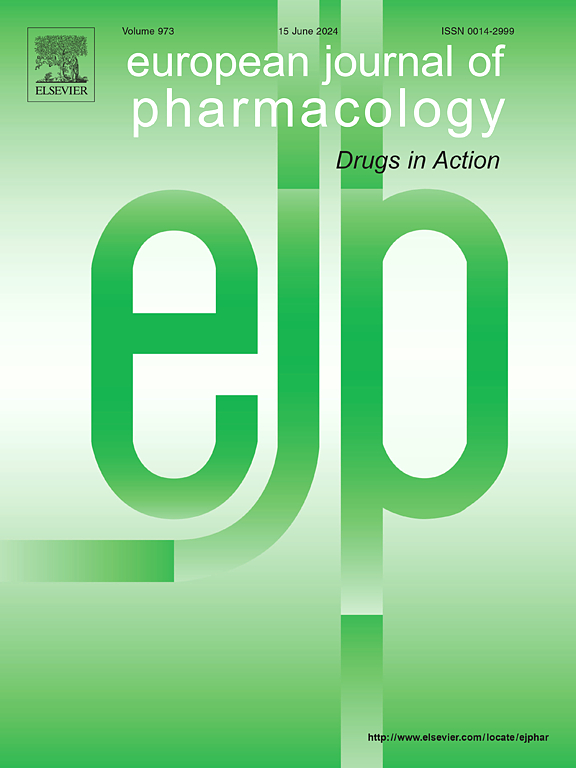Amiodarone oral subacute treatment prevents cardiac dysfunction of ischemia/reperfusion in rats: Mechanisms and influence of hypothyroidism
IF 4.2
3区 医学
Q1 PHARMACOLOGY & PHARMACY
引用次数: 0
Abstract
The antiarrhythmic amiodarone is frequently used, but it induces a risk of hypothyroidism. Their effects on myocardial function after ischemia are unclear. The aim of this work was to evaluate the effects on cardiac recovery during ischemia and reperfusion (I/R) of a subacute oral treatment with amiodarone on rats, and the influence of hypothyroidism, as well as the underlying mechanisms. Hypothyroid rat model (HypoT) was obtained by oral intake of 0.02 % methimazole for 15 days. Amiodarone treatment (30 mg/kg/day) was administered in both HypoT and euthyroid (EuT) rats during a week. Isolated hearts were perfused inside a flow-calorimeter to measure contractile performance (P), total heat rate (Ht) and muscle economy (P/Ht). Hearts were exposed to 30 min I and 45 min R. Moreover, infarct size and western-blot were determined at the end of R. Amiodarone improved the postischemic recovery in EuT rat hearts but reduced it in HypoT rat hearts. By using several selective pharmacological tools, it was demonstrated that amiodarone cardioprotection in EuT rats was strongly reduced by blocking PI3K/AKT, PKC, iNOS and mitochondrial ATP-dependent K+ channels (mKATP). Moreover, the reduced postischemic recovery in HypoT hearts treated with amiodarone was reversed by perfusing a scavenger of oxygen reactive species. Results suggest that protective effects of amiodarone in EuT rat hearts involved a pathway with scavenging of hydroxyl radicals and activation of iNOS, PKC, PI3K/AKT and mKATP channels. However, ROS production was increased in hearts of HypoT rats treated with amiodarone, causing the reduced post-ischemic mechano-energetic recovery.

胺碘酮口服亚急性治疗预防大鼠缺血/再灌注心功能障碍:甲状腺功能减退的机制及影响
抗心律失常胺碘酮是常用的药物,但它有甲状腺功能减退的危险。它们对缺血后心肌功能的影响尚不清楚。本研究的目的是评价亚急性口服胺碘酮对大鼠缺血再灌注(I/R)时心脏恢复的影响,以及对甲状腺功能减退的影响及其潜在机制。口服0.02%甲巯咪唑15 d,建立甲状腺功能减退大鼠模型。HypoT和EuT大鼠均给予胺碘酮治疗(30 mg/kg/天),持续一周。将离体心脏灌注于流量热量计内,测量收缩性能(P)、总热率(Ht)和肌肉经济性(P/Ht)。心肌缺血30min和缺血45min,缺血结束时检测心肌梗死面积和western-blot。胺碘酮可改善缺血大鼠心脏缺血后恢复,但可降低缺血大鼠心脏缺血后恢复。通过几种选择性药理学工具,证明胺碘酮对EuT大鼠的心脏保护作用通过阻断PI3K/AKT、PKC、iNOS和线粒体atp依赖性K+通道(mKATP)而显著降低。此外,用胺碘酮治疗的低氧心脏缺血后恢复的减少可以通过灌注氧活性物质的清除剂来逆转。结果表明,胺碘酮对EuT大鼠心脏的保护作用涉及清除羟基自由基和激活iNOS、PKC、PI3K/AKT和mKATP通道。然而,经胺碘酮处理的HypoT大鼠心脏中ROS的产生增加,导致缺血后机械-能量恢复减少。
本文章由计算机程序翻译,如有差异,请以英文原文为准。
求助全文
约1分钟内获得全文
求助全文
来源期刊
CiteScore
9.00
自引率
0.00%
发文量
572
审稿时长
34 days
期刊介绍:
The European Journal of Pharmacology publishes research papers covering all aspects of experimental pharmacology with focus on the mechanism of action of structurally identified compounds affecting biological systems.
The scope includes:
Behavioural pharmacology
Neuropharmacology and analgesia
Cardiovascular pharmacology
Pulmonary, gastrointestinal and urogenital pharmacology
Endocrine pharmacology
Immunopharmacology and inflammation
Molecular and cellular pharmacology
Regenerative pharmacology
Biologicals and biotherapeutics
Translational pharmacology
Nutriceutical pharmacology.

 求助内容:
求助内容: 应助结果提醒方式:
应助结果提醒方式:


